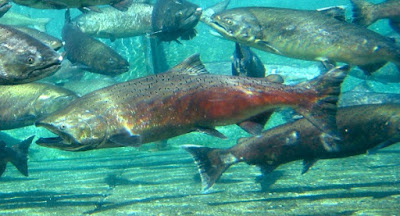Pacific Salmon Guidance Systems
One of the most popular kinds of fish that people eat is salmon, but the good stuff is a mite pricey. Worth it, in my view, but you had best be cooking it up proper-like. Other critters like wolves, birds of prey, and bears eat salmon. You have probably seen movies or documentaries of bears scooping fish out of the stream. It is easier when the streams are full of salmon that are heading up to spawn.
The progress of Pacific salmon is fascinating. They are born in streams, grow up in freshwater areas, then move on to the ocean. This means they are able to adapt from fresh to salt water. When it's time to commence spawning, their guidance systems take them to their places of birth (adapting again to fresh water), spawn, change color, and die. Interestingly, Atlantic salmon do not die right away, but can do their routine several times.
via GIPHY
On a side note, I remember how freshwater salmon in Lake Michigan would go upriver to spawn, and were "snagged". This was done by throwing weighted hooks with multiple points in the water, gouging them, yanking them out, then repeat. "Look at me, I'm a sport fisherman!" No, you're not, Percival. The practice struck me as barbaric, and was outlawed later. But enough of my carping about that.
Salmon are yet another example of our Creator's amazing design abilities, none of which can be explained by fish-to-fish warden philosophies.
 |
| Adult fall Chinook salmon in the Priest Rapids Hatchery, state of Washington Courtesy of Pacific Northwest National Laboratory (Usage does not imply endorsement of site contents) |
via GIPHY
On a side note, I remember how freshwater salmon in Lake Michigan would go upriver to spawn, and were "snagged". This was done by throwing weighted hooks with multiple points in the water, gouging them, yanking them out, then repeat. "Look at me, I'm a sport fisherman!" No, you're not, Percival. The practice struck me as barbaric, and was outlawed later. But enough of my carping about that.
Salmon are yet another example of our Creator's amazing design abilities, none of which can be explained by fish-to-fish warden philosophies.
Hopefully, you're hooked. To read the rest, click on "Pacific salmon — The ocean’s high achievers".One of the great resources of the west coast of the United States and Canada is the multitude of salmon in the coastal ocean and rivers.The life cycle and habits of salmon have been studied in detail because of the fish's usefulness as a food resource — not only for the people of this region, but also as a major export.The building of dams on many of the rivers where salmon return to spawn has made it necessary to invent ways to divert returning fish into artificial hatcheries or to create man-made channels where the fish can return to spawn as naturally as possible. Both methods have proved effective in enhancing the salmon industry and preserving many salmon runs which would otherwise have been destroyed.